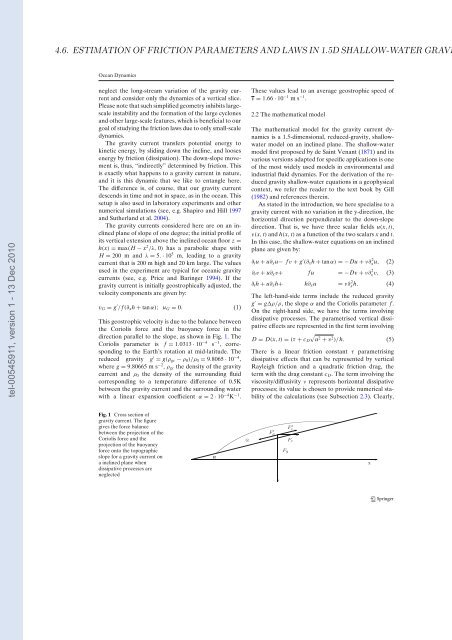Etudes et évaluation de processus océaniques par des hiérarchies ...
Etudes et évaluation de processus océaniques par des hiérarchies ...
Etudes et évaluation de processus océaniques par des hiérarchies ...
You also want an ePaper? Increase the reach of your titles
YUMPU automatically turns print PDFs into web optimized ePapers that Google loves.
4.6. ESTIMATION OF FRICTION PARAMETERS AND LAWS IN 1.5D SHALLOW-WATER GRAVI<br />
Ocean Dynamics<br />
tel-00545911, version 1 - 13 Dec 2010<br />
neglect the long-stream variation of the gravity current<br />
and consi<strong>de</strong>r only the dynamics of a vertical slice.<br />
Please note that such simplified geom<strong>et</strong>ry inhibits largescale<br />
instability and the formation of the large cyclones<br />
and other large-scale features, which is beneficial to our<br />
goal of studying the friction laws due to only small-scale<br />
dynamics.<br />
The gravity current transfers potential energy to<br />
kin<strong>et</strong>ic energy, by sliding down the incline, and looses<br />
energy by friction (dissipation). The down-slope movement<br />
is, thus, “indirectly” d<strong>et</strong>ermined by friction. This<br />
is exactly what happens to a gravity current in nature,<br />
and it is this dynamic that we like to entangle here.<br />
The difference is, of course, that our gravity current<br />
<strong>de</strong>scends in time and not in space, as in the ocean. This<br />
s<strong>et</strong>up is also used in laboratory experiments and other<br />
numerical simulations (see, e.g. Shapiro and Hill 1997<br />
and Sutherland <strong>et</strong> al. 2004).<br />
The gravity currents consi<strong>de</strong>red here are on an inclined<br />
plane of slope of one <strong>de</strong>gree; the initial profile of<br />
its vertical extension above the inclined ocean floor z =<br />
h(x) = max(H − x 2 /λ, 0) has a <strong>par</strong>abolic shape with<br />
H = 200 m and λ = 5. · 10 5 m, leading to a gravity<br />
current that is 200 m high and 20 km large. The values<br />
used in the experiment are typical for oceanic gravity<br />
currents (see, e.g. Price and Baringer 1994). If the<br />
gravity current is initially geostrophically adjusted, the<br />
velocity components are given by:<br />
v G = g ′ /f(∂ x h + tan α); u G = 0. (1)<br />
This geostrophic velocity is due to the balance b<strong>et</strong>ween<br />
the Coriolis force and the buoyancy force in the<br />
direction <strong>par</strong>allel to the slope, as shown in Fig. 1. The<br />
Coriolis <strong>par</strong>am<strong>et</strong>er is f = 1.0313 · 10 −4 s −1 , corresponding<br />
to the Earth’s rotation at mid-latitu<strong>de</strong>. The<br />
reduced gravity g ′ = g(ρ gc − ρ 0 )/ρ 0 = 9.8065 · 10 −4 ,<br />
where g = 9.80665 m s −2 , ρ gc the <strong>de</strong>nsity of the gravity<br />
current and ρ 0 the <strong>de</strong>nsity of the surrounding fluid<br />
corresponding to a temperature difference of 0.5K<br />
b<strong>et</strong>ween the gravity current and the surrounding water<br />
with a linear expansion coefficient α = 2 · 10 −4 K −1 .<br />
These values lead to an average geostrophic speed of<br />
v = 1.66 · 10 −1 m s −1 .<br />
2.2 The mathematical mo<strong>de</strong>l<br />
The mathematical mo<strong>de</strong>l for the gravity current dynamics<br />
is a 1.5-dimensional, reduced-gravity, shallowwater<br />
mo<strong>de</strong>l on an inclined plane. The shallow-water<br />
mo<strong>de</strong>l first proposed by <strong>de</strong> Saint Venant (1871) and its<br />
various versions adapted for specific applications is one<br />
of the most wi<strong>de</strong>ly used mo<strong>de</strong>ls in environmental and<br />
industrial fluid dynamics. For the <strong>de</strong>rivation of the reduced<br />
gravity shallow-water equations in a geophysical<br />
context, we refer the rea<strong>de</strong>r to the text book by Gill<br />
(1982) and references therein.<br />
As stated in the introduction, we here specialise to a<br />
gravity current with no variation in the y-direction, the<br />
horizontal direction perpendicular to the down-slope<br />
direction. That is, we have three scalar fields u(x, t),<br />
v(x, t) and h(x, t) as a function of the two scalars x and t.<br />
In this case, the shallow-water equations on an inclined<br />
plane are given by:<br />
∂ t u + u∂ x u− fv + g ′ (∂ x h + tan α) = −Du + ν∂x 2 u, (2)<br />
∂ t v + u∂ x v+ f u = −Dv + ν∂x 2 v, (3)<br />
∂ t h + u∂ x h+ h∂ x u = ν∂x 2 h. (4)<br />
The left-hand-si<strong>de</strong> terms inclu<strong>de</strong> the reduced gravity<br />
g ′ = gρ/ρ, the slope α and the Coriolis <strong>par</strong>am<strong>et</strong>er f .<br />
On the right-hand si<strong>de</strong>, we have the terms involving<br />
dissipative processes. The <strong>par</strong>am<strong>et</strong>rised vertical dissipative<br />
effects are represented in the first term involving<br />
D = D(x, t) = (τ + c D<br />
√<br />
u2 + v 2 )/h. (5)<br />
There is a linear friction constant τ <strong>par</strong>am<strong>et</strong>rising<br />
dissipative effects that can be represented by vertical<br />
Rayleigh friction and a quadratic friction drag, the<br />
term with the drag constant c D . The term involving the<br />
viscosity/diffusivity ν represents horizontal dissipative<br />
processes; its value is chosen to provi<strong>de</strong> numerical stability<br />
of the calculations (see Subsection 2.3). Clearly,<br />
Fig. 1 Cross section of<br />
gravity current. The figure<br />
gives the force balance<br />
b<strong>et</strong>ween the projection of the<br />
Coriolis force and the<br />
projection of the buoyancy<br />
force onto the topographic<br />
slope for a gravity current on<br />
a inclined plane when<br />
dissipative processes are<br />
neglected<br />
α
















